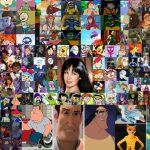Cartoons and Gender Representation: Cartoons, as a form of visual storytelling, play a significant role in shaping societal perceptions and attitudes, including gender-related ones. For decades, animated shows have been instrumental in reflecting and influencing cultural norms, often contributing to the reinforcement or challenging of gender stereotypes. This article explores the complex relationship between cartoons and gender representation, examining the historical context, impact on perceptions, and the evolving landscape of gender inclusivity in animated content.

Historical Perspectives on Gender in Cartoons:
1. Early Gender Stereotypes:
The early days of animation were marked by rigid gender stereotypes, with cartoons often portraying simplistic and traditional roles for male and female characters. Female characters were frequently relegated to domestic roles, embodying stereotypes of the nurturing housewife or the damsel in distress, while male characters took on more adventurous and leadership-oriented roles.
2. Evolution of Female Characters:
Over time, there has been a gradual evolution in the portrayal of female characters in cartoons. The feminist movements of the 20th century influenced cultural perspectives, leading to a reevaluation of gender roles. Animated shows like “The Powerpuff Girls” and “Sailor Moon” introduced strong, independent female characters who challenged traditional gender norms.
3. Perpetuation of Stereotypes:
Despite advancements, gender stereotypes persisted in many cartoons, reflecting broader societal attitudes. Male characters were often depicted as assertive, confident leaders, while female characters faced limitations regarding agency and diversity in their roles. This perpetuation of stereotypes influenced how viewers, particularly children, perceived gender roles.

Impact on Perceptions of Gender Roles:
1. Early Socialization:
Cartoons play a crucial role in the early socialization of children. Animated characters serve as role models and influence how children perceive their own gender identity and the roles they are expected to fulfill. Early exposure to gender stereotypes in cartoons can shape attitudes, behaviors, and expectations that persist into adulthood.
2. Reinforcement of Gender Norms:
Cartoons have the power to reinforce or challenge societal gender norms. When male and female characters conform to traditional stereotypes, it reinforces existing beliefs about the roles and capabilities of men and women. The repetition of these patterns can contribute to the normalization of gender-based expectations.
3. Impact on Body Image:
Portraying idealized body images in cartoons can also influence perceptions of beauty and attractiveness. Female characters, in particular, have historically been depicted with exaggerated and unrealistic physical features, contributing to the development of body image issues and insecurities among viewers.

Evolving Trends in Gender Representation:
1. Diverse Female Characters:
There has been a noticeable shift towards more diverse and multidimensional female characters in cartoons in recent years. Shows like “Steven Universe” and “She-Ra and the Princesses of Power” feature strong, complex female protagonists with a range of personalities, abilities, and roles that go beyond traditional stereotypes.
2. Breaking Gender Norms:
Progressive cartoons challenge traditional gender norms by featuring male characters who are nurturing, empathetic, and emotionally expressive, breaking away from the stoic, tough-guy archetype. This inclusivity expands the range of acceptable behaviors for male and female characters, encouraging a more authentic representation of gender diversity.
3. LGBTQ+ Representation:
Including LGBTQ+ characters and storylines in cartoons is a significant step towards a more inclusive representation of gender identities. Cartoons like “Adventure Time” and “The Legend of Korra” have introduced LGBTQ+ characters, helping to normalize diverse gender and sexual identities for young audiences.

Challenges in Gender Representation:
1. Lack of Diversity:
Despite positive strides, challenges persist in achieving true gender diversity in cartoons. The industry still lacks representation for various gender identities, ethnicities, body types, and abilities. This underrepresentation can limit the diversity of experiences and perspectives reflected in animated content.
2. Tokenism and Stereotyping:
Some attempts at inclusivity in cartoons may fall into the trap of tokenism, where characters from marginalized groups are included superficially without meaningful development. Additionally, stereotypes surrounding gender, race, and sexuality can persist in subtle ways, perpetuating harmful narratives even when creators aim for inclusivity.
3. Industry Representation:
The gender disparity extends beyond the characters on screen to the creators behind the scenes. The animation industry has historically been male-dominated, and the underrepresentation of women in creative roles can impact the portrayal of female characters. Increasing gender diversity in the industry is crucial for fostering authentic and nuanced storytelling.

Positive Examples of Gender Representation:
1. “Avatar: The Last Airbender” (2005-2008):
“Avatar: The Last Airbender” is praised for its well-developed female characters who defy traditional gender norms. Characters like Katara and Toph exhibit strength, leadership, diverse skills, challenging stereotypes, and provide positive role models for young viewers.
2. “Gravity Falls” (2012-2016):
“Gravity Falls” features well-rounded female characters like Mabel Pines, who defy traditional gender expectations. Mabel is portrayed as creative, adventurous, and confident, showcasing a character whose personality goes beyond conventional norms.
3. “Craig of the Creek” (2018-present):
“Craig of the Creek” is notable for its diverse representation, including solid and dynamic female characters like Kelsey. The show prioritizes inclusivity and challenges stereotypes, promoting a positive message of acceptance and friendship.

The Role of Parental Guidance:
1. Open Dialogue with Children:
Parents play a crucial role in shaping their children’s perspectives on gender. Engaging in open dialogues about gender representation in cartoons allows parents to guide their children in critically analyzing and understanding the messages conveyed by animated content.
2. Introducing Diverse Media:
Parents can actively introduce a diverse range of media to their children, including cartoons that break away from traditional gender norms. Exposure to various characters and storylines broadens children’s understanding of gender diversity and fosters empathy and inclusivity.
3. Advocating for Inclusivity:
Parents can advocate for greater inclusivity in animated content by supporting shows prioritizing authentic gender representation. Expressing concerns about harmful stereotypes or applauding positive portrayals can contribute to the demand for more diverse and inclusive cartoons.

The Future of Gender Representation in Cartoons:
1. Continued Push for Diversity:
The future of gender representation in cartoons will likely see a continued push for diversity and inclusivity. As societal norms evolve, there will be an increased demand for authentic portrayals of gender identities, breaking away from outdated stereotypes and embracing the richness of human experiences.
2. Intersectionality and Nuanced Storytelling:
Cartoons will likely explore intersectionality, acknowledging that individuals embody multiple identities, including gender, race, and sexuality. Nuanced storytelling that reflects the complexities of human experiences will become increasingly prevalent, contributing to a more authentic representation of diverse characters.
3. Empowering Young Creators:
Empowering young creators from diverse backgrounds to enter the animation industry is crucial for fostering various perspectives. As more voices contribute to storytelling, the potential for authentic and inclusive representation increases, shaping the future of cartoon gender portrayals.

Conclusion:
Cartoons have the power to both reflect and shape societal perceptions of gender. From the early days of reinforcing stereotypes to the present, where strides are being made toward more inclusive and diverse representation, animated content plays a pivotal role in shaping how individuals view themselves and others.

The evolving landscape of gender representation in cartoons reflects broader societal changes and challenges. While progress has been made, there is still work to ensure that animated content authentically portrays the diversity of gender identities and experiences. By fostering inclusivity, challenging stereotypes, and amplifying diverse voices, the world of cartoons can contribute to a more equitable and understanding society—one animated character at a time.

Read also
- Analyzing Gender Representation in Editorial Cartoons
- Breaking the Mold: Gender Representation in Animated Shows
- Exploring Gender and Diversity Representation in Cartoons: A Comprehensive Analysis
- The Evolution of LGBTQ+ Representation in Comics: A Comprehensive Analysis
FAQs about Cartoons and Gender Representation: Shaping Perceptions
Q1: Why is gender representation in cartoons important?
A1: Gender representation in cartoons is crucial as it influences how individuals perceive and understand gender roles. Cartoons can shape societal norms and contribute to reinforcing stereotypes or promoting inclusivity and diversity.
Q2: How do cartoons impact children’s perceptions of gender roles?
A2: Cartoons are a powerful medium that can influence children’s perceptions of gender roles by portraying certain behaviors, occupations, and characteristics associated with specific genders. Positive and diverse representations can encourage open-mindedness, while stereotypes can limit children’s views.
Q3: Are there notable examples of positive gender representation in cartoons?
A3: Yes, some cartoons have made strides in positive gender representation. Shows like “She-Ra and the Princesses of Power” and “Steven Universe” feature strong, diverse, and complex female characters, challenging traditional stereotypes.
Q4: Do cartoons perpetuate harmful gender stereotypes?
A4: Unfortunately, some cartoons perpetuate harmful gender stereotypes by portraying one-dimensional characters, reinforcing traditional roles, and emphasizing physical appearance over abilities. It’s essential to critically evaluate content for potential negative impacts.
A5: Parents and guardians can actively engage with the content their children consume. Choosing shows with diverse characters, initiating discussions about gender roles, and encouraging critical thinking can help children develop a more nuanced understanding of gender representation.
Q6: Can cartoons play a role in promoting gender equality?
A6: Absolutely. Cartoons have the potential to challenge stereotypes, break gender norms, and promote equality. By featuring diverse characters with varied strengths and qualities, cartoons can contribute to fostering a more inclusive and accepting society.
Q7: What impact does gender representation in cartoons have on adults?
A7: Gender representation in cartoons continues to influence adults by shaping perceptions and reinforcing societal attitudes. By challenging stereotypes, cartoons can promote equality and broaden perspectives among adult audiences.
Q8: Are there initiatives within the animation industry to improve gender representation?
A8: There are ongoing initiatives within the animation industry to improve gender representation. Some studios are actively working to create more diverse and inclusive content, addressing concerns about stereotypes and fostering positive change.
Q9: How can creators ensure responsible gender representation in cartoons?
A9: Creators can ensure responsible gender representation by avoiding stereotypes, creating multidimensional characters, and consulting with experts to gain insights into diverse experiences. Seeking feedback from diverse audiences during the development process is also crucial.
Q10: What role can viewers play in advocating for better gender representation in cartoons?
A10: Viewers can advocate for better gender representation by supporting shows that portray characters breaking traditional norms, engaging in discussions about representation, and calling out instances of harmful stereotypes. Viewer feedback can influence the industry to prioritize inclusivity.
This post was created with our nice and easy submission form. Create your post!





2 Comments